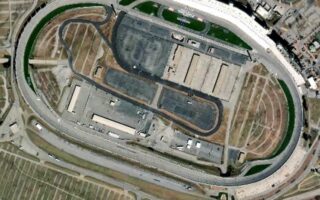The Darlington Southern 500: A Timeless Tribute to Racing Heritage
Nestled in the heart of South Carolina, the Darlington Raceway stands as a revered testament to the enduring spirit of stock car racing. Among its storied events, the Southern 500 looms large as a hallmark of tradition and competition, captivating fans with its rich history and exhilarating spectacle. Since its inception in 1950, this legendary race has not only showcased the prowess of elite drivers but has also become a cultural touchstone for motorsport enthusiasts. Known for its unique oval shape and challenging turns, Darlington serves as a proving ground where legends are born and rivalries ignite. As the engines roar and the tires screech on its iconic surface, the Southern 500 continues to weave a narrative that celebrates the legacy of racing while thrilling generations of fans, reminding us all why we are drawn to the fast-paced world of NASCAR. In this article, we delve into the history, significance, and captivating stories that surround the Southern 500, exploring what makes this race an indelible part of America’s motorsport landscape.
Table of Contents
- Exploring the Historic Roots of the Darlington Southern 500
- Key Strategies for Teams in the Unique Challenge of Darlington Raceway
- Fan Experience Enhancements for a Memorable Southern 500 Weekend
- Understanding the Tracks Influence on Race Outcomes and Driver Performance
- Q&A
- In Retrospect
Exploring the Historic Roots of the Darlington Southern 500
The Darlington Southern 500 holds a prestigious place in NASCAR history, celebrated not only for its thrilling races but also for its deep roots in the American sporting culture. Established in 1950, it was one of the first events in the NASCAR Cup Series, paving the way for stock car racing as we know it today. The race takes place at the iconic Darlington Raceway, known for its unique oval shape and challenging turns, which have earned it the affectionate nickname, “The Lady in Black.” The track’s distinctive design often leads to an emotionally charged atmosphere, as drivers confront their limits on a grueling half-mile circuit that has tested legends and newbies alike.
Over the decades, the Southern 500 has been a canvas for legendary rivalries and unforgettable moments. As fans flock to the stands, they witness history unfold with each lap, as many of NASCAR’s greatest names have etched their victories into the annals of the sport. Factors such as the evolution of race technology and changes in car design have highlighted the growing complexity of the racing scene, yet the heart of the Southern 500 remains unchanged. To understand the significance of this race, consider its historical milestones:
- First Race in 1950: Marking the beginning of a legacy.
- Iconic Winners: Featuring legends such as Richard Petty, Dale Earnhardt, and Jeff Gordon.
- Unique Challenges: Known for its tough turns and the famed “Darlington Stripe.”
Key Strategies for Teams in the Unique Challenge of Darlington Raceway
Competing at Darlington Raceway demands a distinct approach, as it embodies a blend of high-speed thrills and technical challenges. To navigate this unique track, teams must prioritize strategic tire management, ensuring that their rubber can endure the grueling conditions while maximizing performance. A well-timed pit strategy that considers weather changes and track conditions can drastically influence race outcomes, providing teams an edge over their competitors. Additionally, emphasizing communication within the pit crew is essential—clear signals and rapid responses can make the difference between a smooth pit stop and a costly delay.
Moreover, the importance of car handling adjustments cannot be overstated at a track known for its abrasive surface and unique egg-shaped layout. Teams should focus on fine-tuning suspension settings and aerodynamic components to achieve optimal grip and stability. Utilizing real-time data analysis tools can provide insights into the car’s performance, allowing for immediate adjustments during practice sessions and races. This adaptability, combined with a deep understanding of the track’s nuances, is vital for success at Darlington. To encapsulate the core strategies to enhance performance:
| Key Strategies | Focus Areas |
|---|---|
| Tire Management | Optimal wear and tear analysis |
| Pit Strategy | Timely and efficient stops |
| Communication | Clear and rapid coordination |
| Car Adjustments | Suspension and aerodynamic tuning |
| Data Analysis | Real-time performance tracking |
Fan Experience Enhancements for a Memorable Southern 500 Weekend
As fans gear up for the exhilarating Southern 500 weekend at Darlington Raceway, several enhancements have been introduced to elevate the experience like never before. Expect to see a vibrant atmosphere filled with interactive displays, live music, and culinary delights that showcase the best of Southern culture. Attendees can participate in engaging activities, including:
- Driver Meet & Greet: A unique opportunity to interact with your favorite drivers.
- Fan Zones: Areas featuring unique merchandise, photo ops, and simulators.
- Food Festivals: Indulge in local flavors from various food trucks and vendors.
To ensure you don’t miss a moment of the action, the event will also feature enhanced accessibility options and improved transportation services. Here’s a breakdown of the key features:
| Enhancement | Details |
|---|---|
| Extended Shuttle Service | Frequent shuttles running from major hotels and parking areas. |
| Improved Wi-Fi Connectivity | Stream your favorite moments live with reliable internet access. |
| Family-Friendly Zones | Special areas with kid-friendly activities and entertainment. |
Understanding the Tracks Influence on Race Outcomes and Driver Performance
When it comes to racing, the unique characteristics of a track can significantly dictate not only the outcome of a race but also the performance of individual drivers. At Darlington, known as “The Lady in Black,” the track’s distinctive egg-shaped oval layout presents both challenges and opportunities. With its worn-out asphalt and tight turns, drivers must exhibit a blend of aggression and patience. The high-speed straightaways allow for overtaking maneuvers, while the narrow corners demand precision in handling. This delicate balance creates an atmosphere where even the slightest miscalculation can lead to costly mistakes, greatly influencing the final standings.
Moreover, the track’s surface plays a pivotal role in tire management strategies, which can vary widely among teams. Factors like tire wear, track position, and driver adaptability determine how well a competitor can navigate the treacherous conditions of Darlington. The following table outlines key aspects that affect driver performance at this iconic venue:
| Factor | Impact on Performance |
|---|---|
| Track Surface | Increases tire degradation; requires strategic pit stops |
| Corner Banking | Affects speed through turns; necessitates skillful car control |
| Race Temperature | Influences tire grip and engine performance; affects driver stamina |
| Fan Engagement | Motivates drivers; enhances competitive spirit |
Q&A
Q&A: Understanding the Darlington Southern 500
Q1: What is the Darlington Southern 500?
A: The Darlington Southern 500 is an iconic NASCAR Cup Series race held annually at Darlington Raceway in South Carolina. It marks one of the oldest traditions in stock car racing, dating back to its inception in 1950. This race, known for its distinctive egg-shaped oval track, challenges drivers with its unique turns and is often referred to as “Too Tough to Tame.”
Q2: Why is Darlington Raceway significant in NASCAR history?
A: Darlington Raceway holds a special place in NASCAR history as it was one of the first paved tracks and played a significant role in the evolution of stock car racing. Its unique design, characterized by a narrow and uneven surface, emphasizes driver skill and strategic pit stops. The Southern 500 has also been a part of NASCAR’s early traditions, contributing to the sport’s growth and popularity.
Q3: What makes the Southern 500 a challenging race for drivers?
A: The Southern 500 presents numerous challenges for drivers. The track’s uneven corners and varying banking require exceptional skill and precision. It often tests a driver’s stamina and concentration as they race for 500 miles, making it a true testament to both driving and team strategy. Additionally, the possibility of tire wear and changing weather conditions can significantly affect race outcomes.
Q4: How has the Southern 500 evolved over the years?
A: Over the years, the Southern 500 has seen various changes in its format and scheduling. Originally held on Labor Day weekend, the race has transitioned to the NASCAR Playoffs, making it a critical part of the playoff picture. Technological advancements in car design and pit strategy have also evolved, altering how teams approach the race. Despite these changes, the essence of the Southern 500 remains rooted in its rich history.
Q5: Who are some legendary drivers associated with the Southern 500?
A: Many legendary drivers have etched their names in the history of the Southern 500, including legends like Dale Earnhardt, Richard Petty, and Bobby Allison. More contemporary stars, such as Jimmie Johnson and Kyle Busch, have also experienced success at this prestigious event. The race has witnessed countless memorable performances and dramatic finishes, making it a pivotal race on the NASCAR calendar.
Q6: What can fans expect when attending the Southern 500?
A: Fans attending the Southern 500 can expect an electric atmosphere filled with excitement and passion for racing. The experience includes not only the race but also various activities such as fan meet-and-greets, live music, and merchandise stands. The opportunity to see the cars up close and engage with fellow fans adds to the overall appeal of the event, making it a must-visit for motorsports enthusiasts.
Q7: How does the Southern 500 contribute to the local economy?
A: The Southern 500 significantly contributes to the local economy, attracting thousands of visitors to the area. Hotels, restaurants, and local businesses benefit from the influx of fans and teams during race weekend. The event generates tourism revenue and creates seasonal jobs, reinforcing the importance of the race not just in sports history but also in community growth.
Q8: What are some memorable moments in Southern 500 history?
A: The Southern 500 has provided fans with countless memorable moments, from nail-biting finishes to surprising upsets. One standout moment occurred in 1984 when Richard Petty secured his 200th career win at Darlington, a feat that cemented his legacy in NASCAR history. There are also dramatic crashes, strategic pit calls, and last-lap battles that have become part of the race’s lore, keeping fans on the edge of their seats.
This Q&A offers a glimpse into the rich history and significance of the Darlington Southern 500, capturing its essence and impact on the world of NASCAR and its fans alike.
In Retrospect
As the sun sets over the historic Darlington Raceway, the echoes of engines revving and tires screeching remind us why the Southern 500 holds a special place in the hearts of racing enthusiasts. This event, steeped in tradition and excitement, not only showcases the skill and determination of the drivers but also celebrates the rich legacy of motorsport in the South. Whether you are a lifelong fan or a newcomer to the scene, the Southern 500 offers a unique blend of nostalgia and adrenaline. As we look ahead to the next race, one thing remains clear: the spirit of Darlington will continue to thrive on the asphalt, carving stories into the annals of racing history for years to come. So, buckle up and stay tuned—the track is never done telling its tales.


